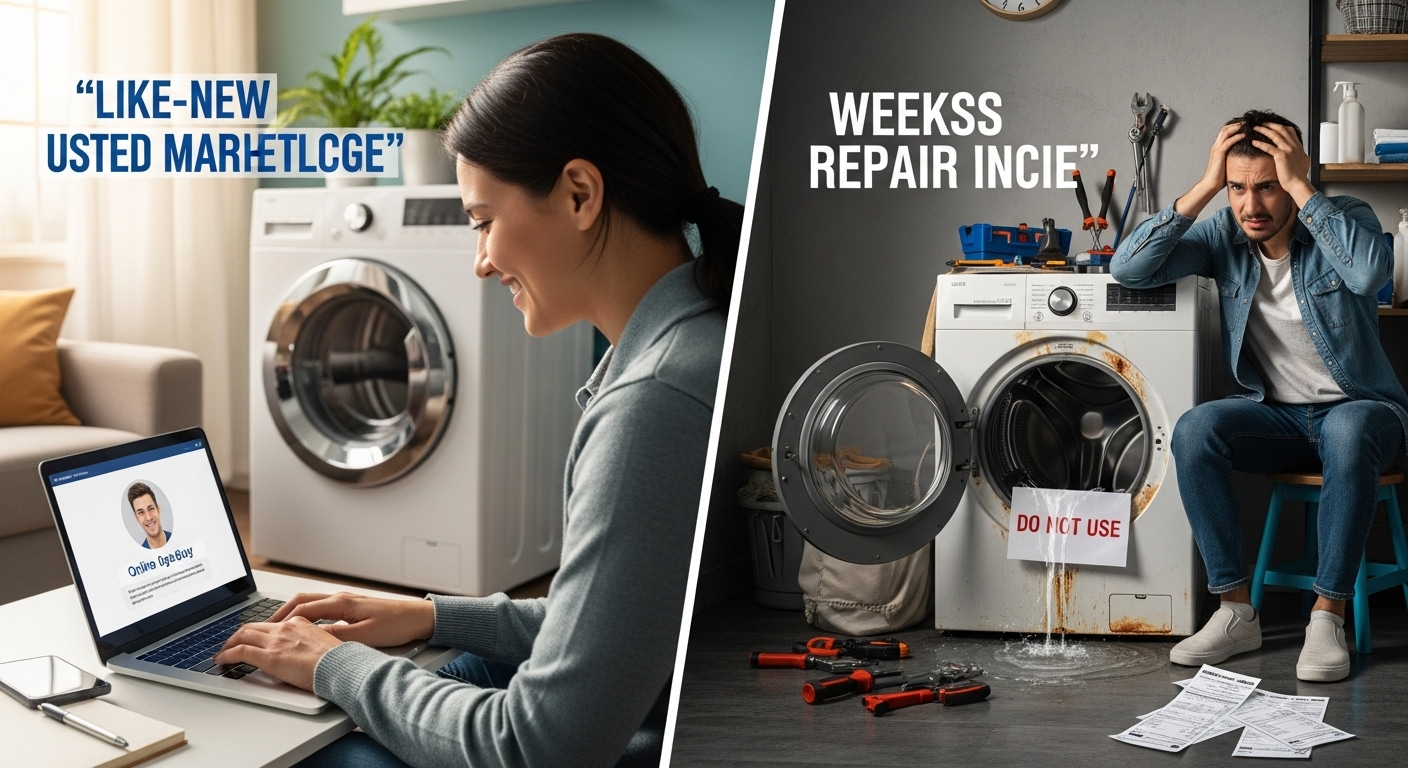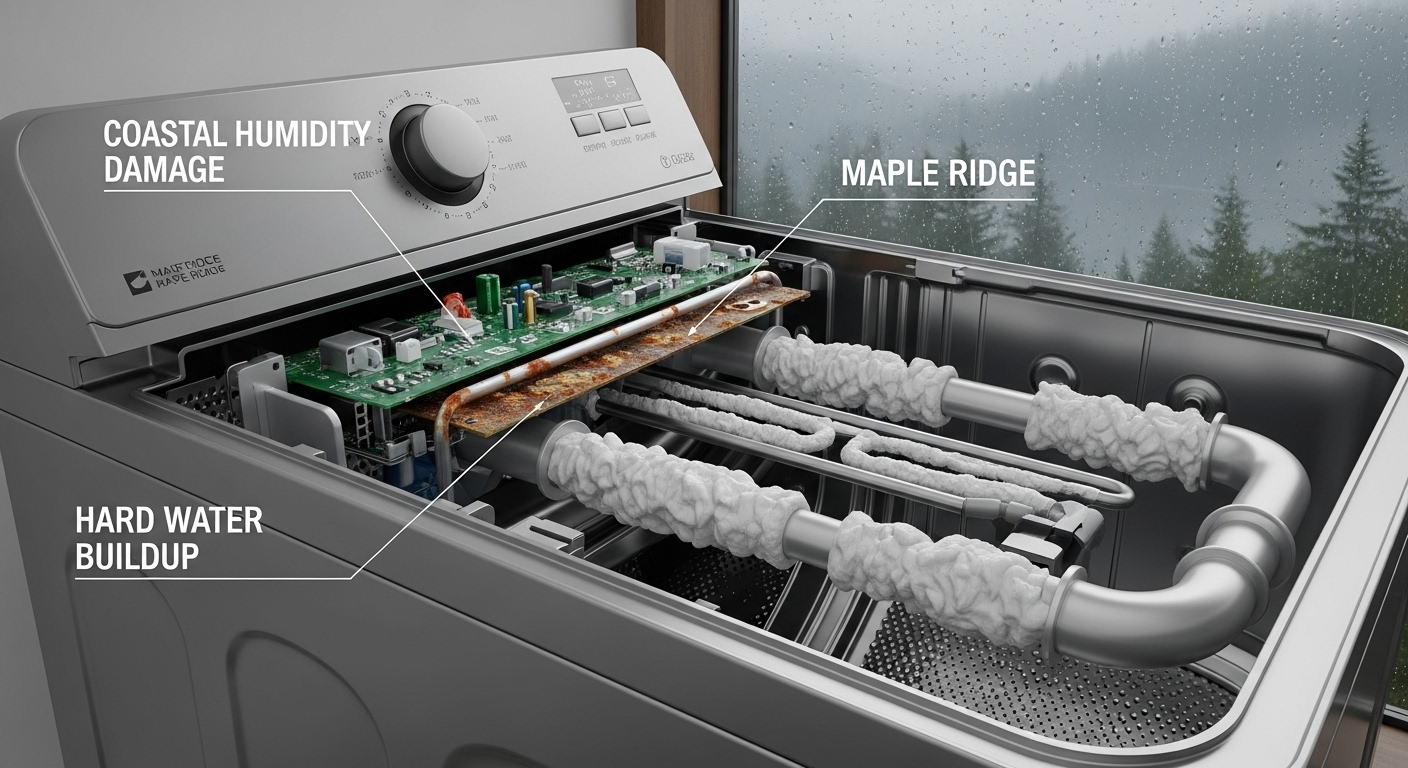How Buying Used Appliances Can Backfire: Hidden Problems That Cost Maple Ridge Homeowners More Than New Purchases
Tempted by that “like new” washer on Facebook Marketplace for half the retail price, or considering that used refrigerator from your neighbor to save a few hundred bucks? Before you hand over your cash, you need to know about the hidden problems that turn these “bargains” into expensive mistakes that could cost you thousands more than just buying new.
Picture this: you’re scrolling through Craigslist and spot a gorgeous stainless steel dishwasher for $300 when the same model costs $800 new. It looks perfect in the photos, the seller swears it “runs like a dream,” and you’re already mentally spending the $500 you’re about to save on that kitchen backsplash project. Fast forward three months, and you’ve shelled out $200 for a diagnostic call, another $250 for pump replacement, and now you’re staring at a $400 estimate for control board repair on an appliance you paid $300 for. Sound familiar?
As someone who learned this lesson the hard way (RIP to my “amazing deal” dryer that literally caught fire two weeks after purchase), I’ve become obsessed with understanding why used appliances seem like such smart buys but end up being financial disasters. The reality is that Maple Ridge’s unique coastal climate, combined with the hidden costs of repairs, lack of warranties, and safety risks, makes used appliance purchases far riskier than most homeowners realize. What looks like a 50% savings upfront often ends up costing 20-30% more over the appliance’s remaining lifespan when you factor in all the unexpected expenses that come with buying someone else’s problem.
Key Outtakes:
- Maple Ridge’s coastal climate and mineral-rich water accelerate used appliance deterioration at rates 20-40% faster than other regions, creating hidden damage that surfaces months after purchase
- Average used appliance buyers face $100-$300 repair costs per incident, with most experiencing 2-3 service calls within the first year, potentially doubling their initial savings
- Over 85% of used appliances sold privately come with zero warranty coverage, leaving homeowners fully responsible for all repairs unlike new appliances with manufacturer protection
- Used electrical appliances without safety inspections cause 89% of electrical house fires, with faulty white goods accounting for approximately five fires per day in residential areas
- While new appliances last 10-15 years, used appliances typically have only 2-5 years of functional life remaining, creating a false economy when repair costs are included

The Environmental Reality That Destroys Used Appliances in Maple Ridge

Here’s what most used appliance guides won’t tell you: Maple Ridge’s location creates the perfect storm for accelerated appliance deterioration. Our coastal proximity brings persistent humidity levels of 60-80% that penetrate appliance housings and corrode electronic components at rates that would shock you. I learned this firsthand when that “barely used” washing machine I bought started showing rust stains around the control panel just six weeks after purchase.
The mineral content in our water supply ranges from 120-200 parts per million, which classifies as hard water. This means every used dishwasher, washing machine, and refrigerator with water lines you’re considering has years of mineral buildup clogging internal components. That buildup reduces water flow, makes heating elements work harder, and causes pumps to fail prematurely. Professional descaling runs $150-$300 for washing machines and $100-$200 for refrigerators – costs that sellers conveniently forget to mention when pricing their “deal.”
What makes this particularly brutal for Maple Ridge homeowners is our seasonal temperature swings from -5°C in winter to +25°C in summer. These repeated expansion and contraction cycles stress seals, crack solder joints, and compromise the internal connections that keep appliances running smoothly. Used appliances may look fine during a summer inspection, but once they experience their first winter in your home, those stressed components start failing in cascade fashion.
The settling time requirement for moved refrigerators is especially critical in our climate. Any refrigerator that’s been transported needs to sit upright for 24 hours before plugging in to prevent compressor damage from temperature shock. This isn’t universally required in all climates, but in Maple Ridge’s humidity and temperature variation, skipping this step can cost you $300-$600 in compressor repair within weeks of purchase.
The Hidden Repair Costs That Eliminate Your Savings

Let me break down the math that sellers don’t want you to see. When you buy that $400 used washer instead of spending $700 on a new one, you think you’ve saved $300. But here’s what typically happens in the first year based on local Maple Ridge repair rates and the recurring appliance issues documented in our area.
Your first service call will likely cost $100 just for the diagnostic fee, even if they can’t fix the problem. When they identify the issue – let’s say a faulty drain pump – you’re looking at $125 for the part plus $100-$150 in labor, bringing your first repair to $225-$275. Two months later, when the belt starts slipping because the previous owner ran unbalanced loads for years, that’s another $80 part plus $100 labor. Six months in, when the control board fails due to moisture damage from our coastal humidity, you’re facing a $300-$400 repair or complete replacement.
The brutal reality is that average appliance repair costs in our region run higher than national averages due to labor rates of $50-$125 per hour. Local repair shops charge $95+ for diagnostic calls, and emergency or weekend service adds another 20-30% surcharge. When you add up diagnostic fees, parts costs, labor, and multiple service visits, that $400 used washer often costs you $800-$1,000 before it finally dies completely.
The comparison gets even more depressing when you consider energy efficiency. Used appliances are typically 20-40% less efficient than current models, meaning your utility bills will be $30-$50 higher annually. Over a typical 3-5 year remaining lifespan, that efficiency penalty adds another $150-$250 to your total cost of ownership. Meanwhile, that $700 new washer you skipped comes with a manufacturer warranty covering all these potential failures for the first year, plus 10+ years of expected lifespan with modern energy ratings.
Here’s a real-world scenario I calculated for a Maple Ridge homeowner last month: Used refrigerator purchased for $300 required a $100 diagnostic call, $225 thermostat replacement, $300 condenser repair, and finally a $600 compressor replacement before complete failure. Total spent: $1,125 on a $300 appliance over 18 months. The equivalent new refrigerator cost $650 with a full warranty. The “savings” actually cost this homeowner $475 extra, not counting the inconvenience and food spoilage during repeated breakdowns.
Warranty Gaps That Leave You Completely Exposed

The warranty situation with used appliances is where the financial risk becomes absolutely terrifying. Over 85% of used appliances sold through Facebook Marketplace, Craigslist, or yard sales come with absolutely zero warranty protection. When that control board fails three weeks after you buy it, you own 100% of that problem. The seller’s liability ended the moment you handed over cash, and good luck trying to recover damages through small claims court.
Even when you buy from legitimate used appliance stores, the warranty coverage is typically 30-90 days maximum – just long enough for hidden problems to surface after your protection expires. Compare this to new appliances that come with full manufacturer warranties covering parts and labor for 12 months, plus extended warranty options that actually mean something because they’re backed by established companies with customer service departments.
What most people don’t realize is that manufacturer warranties are almost always non-transferable. That three-year-old dishwasher might have had two years of coverage remaining when the previous owner bought it new, but the moment they sell it to you, that warranty becomes void. You inherit an appliance with zero manufacturer support, no recall protection, and no recourse when inevitable problems arise.

Recent Comments